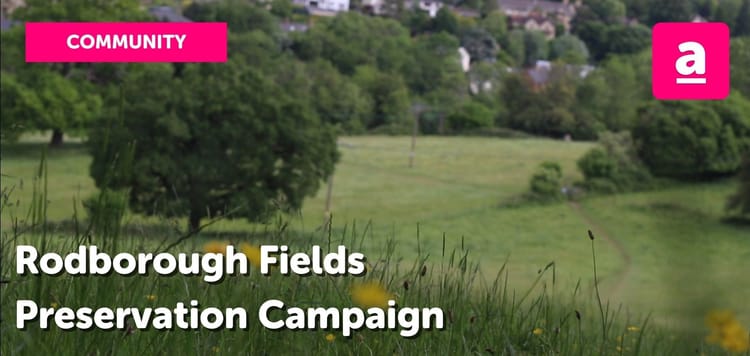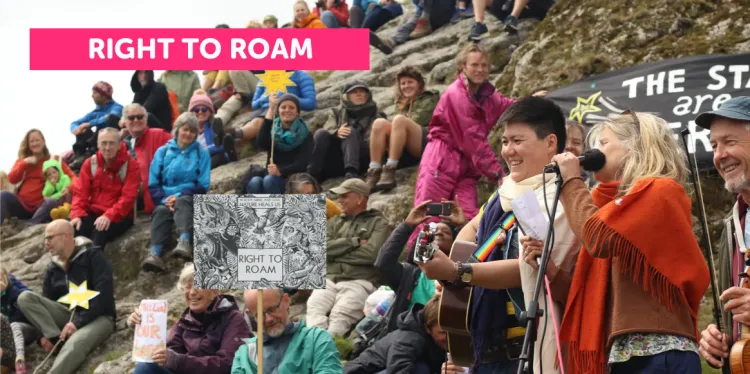#Build Back Better | The Green New Deal

By Beth Wilson
What lessons have we learnt about our relationship with the environment in lockdown? What can we apply not after Coronavirus, but now, both in Stroud and in society as a whole?
In this article we explore the positive environmental effects seen throughout the coronavirus pandemic from reduced carbon emissions and fast-tracked sustainable transport policy. We consider how this could tie into the longer term application of policies such as the Green New Deal, amongst other existing environmental legislation.
It is evident that we need rapid global decarbonisation. UNEP’s Emissions Gap Report shows that we are currently projected for 2.2 degrees warming even with a ‘best effort’ push. The report compares the current emission trajectory with the desired targets of limiting average global temperature increases this century by no more than 1.5-2 degrees Celsius above pre-industrial levels. Indeed, to meet these temperature increase limits, global emissions must fall by 7.6% each year by 2030. If this is not met, the UNEP report points to mass extinctions, sea level increases and drought amongst the usual line-up of environmental impacts likely to worsen. A look at an independent Climate Action Tracker which tracks governmental climate action clearly sees the UK rated as ‘Insufficient’ and the majority of other legally bound nations as ‘Critically Insufficient and ‘Highly Insufficient’. Across this wealth of UN policy and strategy literature, there is heavy emphasis on “recognising the need for effective and progressive response to the urgent threat of climate change.” Changes required are ambitious, but possible. The longer we delay the more pressing the matter becomes, both for the health of our planet and its inhabitants, ourselves unavoidably included. What the current coronavirus crisis has indicated, however, is that momentous state-led behavioural and policy change can happen in a short timescale.
A popular hashtag #buildbackbetter is gaining traction at the moment and indicates that ‘going back to normal’ is not preferable at all, when the status quo is ‘insufficient’ climate action and social inequality. Those who follow Stroud-based Ecotricity will have no doubt seen the slogan #anotherway that is accompanying their commentary on the environmental positives of lockdown lifestyle changes.
With questions being raised over our previous habits, attitudes and the negative climatic impacts of our day to day life, can we carry changes that we’ve had to make in lockdown forward with us to contribute to sustained environmental improvements? As a nation we have already seen a month without coal fired power stations, where renewable energy has contributed 37% of supply. A National Infrastructure Commission report also indicates that half of the UK’s power could be from renewable sources by 2030. With opportunities in the renewable sector seemingly raring to go, it seems troubling that so little government support has been granted to the renewable sector: a reversal in focus is needed to ensure that this hampered and essential sector can be harnessed fully to contribute to carbon emission goals.
Nods to improved air quality in cities, reductions in noise pollution, and increased levels of exercise are just small improvements that we have observed during lockdown. A UK charity, Living Streets are employing the #walkingfromhome hashtag for people to reflect on how their daily walks are contributing to increased senses of wellness and reduced use of vehicles. These personal anecdotes aside, there are also national calls for streets to be re-imagined not post-Covid-19 but now. On 9th May the Department for Transport issued guidance and funding, trickling from the broader ‘Cycling and walking investment strategy, for alternative ways to travel ‘to relieve pressure on public transport’, including:
“Pop-up bike lanes with protected space for cycling, wider pavements, safer junctions, and cycle and bus-only corridors will be created in England within weeks as part of a £250 million emergency active travel fund – the first stage of a £2 billion investment.”
“Yet, the manner in which the policy was fast-tracked to support sustainable and diverse transport could be replicated and advanced by inheriting aspects of the Green New Deal (GND). There have been several calls to enact greener policy in a post-Covid society, but with this point in time extremely difficult to predict and allowing commitments to protract further, there is an impetus to act now. This is especially true if we are already (albeit, insufficiently) heading towards these commitments by signing the Paris Agreement and passing net-zero emissions laws.
What is the Green New Deal (GND)?
Simply put:
“The Green New Deal will deliver a fast and fair transformation of our economy and society, renewing almost every aspect of life in the UK: from the way we produce and consume energy, to the way in which we grow the food we eat, and how we work, travel, and heat our homes.” Green New Deal Group
There are several origin stories and present day manifestations of the GND: for example, The European Green Deal aiming for net zero emissions by 2050, and New York’s ‘OneNYC 2050’ strategy. In terms of the UK flavour though, the framework of the Green New Deal Group came about over 10 years ago, in 2008, with contributors and authors including Ann Pettifor, an engaged political economist. It was also reworked and adapted, formally tabled as the Decarbonisation and Economic Strategy Bill in March 2019 by Caroline Lucas MP and Clive Lewis MP, going on to be published fully later in September 2019. The Labour Party also incorporated key aspects of the Green New Deal and passed it in September’s 2019 Conference in Brighton. This was later baked into the Labour Party Manifesto (launched at Forest Green Rovers football club) as the ‘Green Industrial Revolution’.
A Just Transition.
A key tenet of the Green New Deal is a worker’s-led ‘just transition’; a principle that both reverses adverse austerity whilst simultaneously generating green jobs and economic activity across the nation. In their Unionised Green Jobs report, the campaign group ‘Labour for a Green New Deal’ explain in detail how a ‘Just Transition’ would operate. It would provide unionised, environmentally beneficial jobs, inclusive of fair pay, worker representation, collective decision making, social protections, and training. All of which, at their core, contribute to a transition away from environmentally damaging practises in existing industries without compromising job security.
The Green New Deal Group literature features a comprehensive ‘Jobs in Every Constituency’ report, where many of the anticipated roles would be labour intensive and heavily infrastructure-orientated. These are jobs that have always been difficult to automate, and in turn would keep employment local and stable in each constituency. The same Jobs in Every Constituency programme would focus on large scale improvements to energy efficiency across all of the UK’s buildings, ensuring programmes were in place across the nation, making use of recycled materials in refurbishments and new build construction. Another key aspect of the green jobs programme involves significant policy updates and investment in transport. Encouraging electric vehicle usage and putting in place enhanced road maintenance programmes. Both of these examples, the energy efficiency improvement of buildings and transport infrastructure would not only improve social and environmental quality, but also provide work in communities that cannot be automated easily, offering stable careers, for example in highway maintenance and construction.
As in Stroud’s ‘Rural Service Network Economic Profile’, Stroud’s full-time employment sector is predominantly based in Manufacturing (27.5%), Construction (9%) and Health (9%). Further, as in Figure 1, the most common enterprise types in Stroud are ‘Professional, Scientific and Technical (19%)’, ‘Construction (12%)’, ‘Information and Comms’ and ‘Agriculture (8% each)’. Engineering and scientific technology companies such as Renishaw (with its headquarters in Wotton-under-Edge), dozens of building and construction companies local to Stroud, and the renewable energy company Ecotricity, would doubtlessly feature in such a just transition focussing on green jobs.
| Figure 1: Proportion of Enterprises in each Industry Sector – Stroud, 2016 |
Worries about the threat of job losses in the process of moving away from current conventional fossil fuel hungry sectors are obviously reasonable. A ‘Just Transition’ would, however, ensure that job creation and security is at the core of the shift to sustainable practices. To give an example, a similar transition took place where innovative solutions were employed in the face of a rapid change to policy. Namely, the Nobel peace prize nominated “Lucas Plan“. It is just one illustration showing that in future it will be possible to cut back on environmentally damaging practises whilst also providing jobs that ensure workers retain and develop skills, meeting social and environmental needs.
Workers at Lucas Aerospace, through their committee (the Combine), gave a unified voice on matters such as pay, pension and other labour issues. When a restructure and redundancies surfaced in response to international competition, they proposed an ‘Alternative Corporate Plan’ for the company including prototypes. They indicated that it was possible to retain jobs through alternative, socially useful products and innovations. Although the Lucas Plan focussed on shifting away from weapons manufacturing, the process of asking what could be done with the skills, technology, and experience to adapt innovatively mirrors today’s perceived hurdle of ‘greening’. Ultimately their plan was not taken up, the government showed a reluctant willingness to talk, but didn’t seriously consider their prototypes. Yet, the example clearly demonstrated the possibility of pre-existing workforces, skillsets and technology providing the means to adapt to requirements in the face of rapid change.
Action in Stroud
With Stroud’s history interwoven with the woollen cloth industry, boasting the Stroudwater Scarlet and the Stroudwater Navigation, it undeniably prides itself on its former industrial heritage. Conversely, modern-day Stroud is clearly home to a radical green culture, being the birthplace of the Extinction Rebellion. There is evidently a primed state of environmental awareness here even outside of these more radical circles, with smaller local schemes such as ‘Blue Hearts and Wild Spaces’. However, can such imperative climate commitments and guiding models such as the Paris Agreement and GND be achieved through schemes such as the broader scale Stroud District Local Plan or Stroud’s Town Centre’s ‘Neighbourhood Development Plan?
The Local Plan aims for net zero by 2035, yet the UK has legislated to become net-zero by 2050 in line with the Paris Agreement. Indeed, these two Stroud planning documents feature many references to ‘greening’ and ambitious targets. In December 2018 Stroud Town Council declared a climate emergency and committed to become a carbon neutral organisation by 2030, encouraging the local community to also reduce emissions and garner resilience to climate change.
But how can these goals be enabled? Indeed, as the Carbon Brief have highlighted, there is often a confusing reframing of targets, which seemingly shift the goalposts when trying to reach for decarbonisation goals. Do we focus on carbon budgets, temperature targets or atmospheric concentrations? The controversial Javelin Park Incinerator purportedly reduces carbon emissions, whilst diverting waste from landfill. But there are unanswered questions regarding very fine particulate emissions and the implications for human and environmental health. Indeed, such projects may not tackle the underlying fact that society’s part in generating waste, and other environmentally negligent behaviour further upstream, need to change. This local contradiction is perhaps a paradigm for the broader scale question applicable to the global climate crisis.
These questions are important and difficult to answer, yet it is obvious that assurances and momentum are needed from the top-down national scale and also at a more grass roots local scale, to bring any coherent change.
The Task Ahead
The UNEP report outlines that global emissions must fall by 7.6% each year from 2020 to rein in an absolute “best case” increase of 1.5 degrees and upper limit of 2 degrees goals as set out in the Paris Agreement. In April we saw daily CO2 emissions falling by 17% compared to daily 2019 levels in accordance with large scale and rapid behavioural scale brought about by lockdown. Some worry that these behavioural changes, and therefore environmental indicators, may reverse after “normality” resumes, as already seen with China’s air pollution levels rebounding to pre-pandemic levels.
Indeed, estimates of global annual carbon emissions reductions due to coronavirus are placed at 5.5%, compared to the global total emissions in 2019. This is, worryingly, short of the 7.6% annual reduction needed to limit a temperature increase of 1.5-2 degrees. The task ahead therefore looks challenging, and indeed the kind of systemic changes needed to reach net zero, in accordance with GND principles and legislation the UK has already signed cannot happen overnight. Ultimately, a coherent large-scale policy such as the GND must be implemented if our society genuinely wants to reach these global temperature rise limits and emission drops.
Specifically for Stroud, the town has a green framework in its planning policy already and community level solutions to at least make improvements locally towards the goal of carbon net-zero. We have the Farmers Market and a network of initiatives and businesses already fully supporting the cause. As a logical contributing action, it is clear that now is the time to get involved with these community initiatives that Stroud fosters. Through applying pressure for change at the local level, informing and keeping the public engaged with the fact that commitments must be made to climate goals, we may avert succumbing to an altogether different set of crises to the pandemic we are currently navigating.
In the current coronavirus pandemic, the level of engagement and attention to the matter from policymakers and the public is heightened. This kind of relentlessly engaged attitude needs to be applied to the future climate crisis that likely awaits us by demonstrating that alternative schemes are possible, as shown with the GND. Billions of pounds of spending has been released for the furlough scheme to support 7.5 million workers, we have also recently seen a UK first of government bonds (£3.75 billion’s worth) being sold with a negative 0.003% yield. This demonstrates that there is a legitimate case for financing the GND through emergency funding; the precedent has been set by the government’s response to the pandemic. As we stand at this crossroads where environmental, financial and social systems have changed rapidly, it seems an opportunity too good to pass up. Indeed, if we do, our trajectory towards environmental crisis will only worsen.






Member discussion